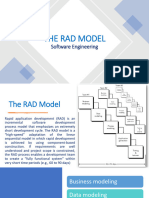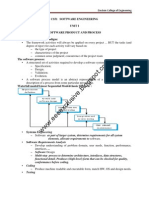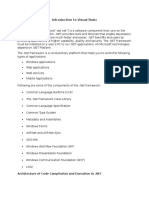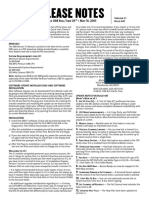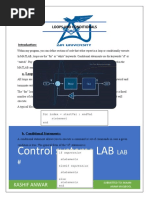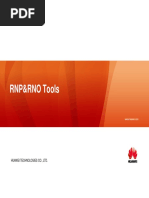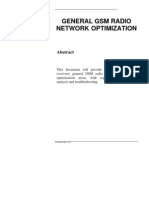Introduction To RAD
Uploaded by
Hassan YassinIntroduction To RAD
Uploaded by
Hassan YassinRapid Application Development
Introduction
The RAD (Rapid Application Development) model is based on prototyping and
iterative development with no specific planning involved. The process of
writing the software itself involves the planning required for developing the
product.
Rapid Application development focuses on gathering customer requirements
through workshops or focus groups, early testing of the prototypes by the
customer using iterative concept, reuse of the existing prototypes
(components), continuous integration and rapid delivery.
What is RAD?
Rapid application development (RAD) is a software development
methodology that uses minimal planning in favor of rapid prototyping. A
prototype is a working model that is functionally equivalent to a component
of the product.
In RAD model the functional modules are developed in parallel as prototypes
and are integrated to make the complete product for faster product delivery.
Since there is no detailed preplanning, it makes it easier to incorporate the
changes within the development process. RAD projects follow iterative and
incremental model and have small teams comprising of developers, domain
experts, customer representatives and other IT resources working
progressively on their component or prototype.
The most important aspect for this model to be successful is to make sure
that the prototypes developed are reusable.
Why to use RAD?
To encourage customer participation and enhance application development
RAD Model Design
RAD model distributes the analysis, design, build, and test phases into a
series of short, iterative development cycles. Following are the phases of RAD
Model:
Business Modeling: The business model for the product under development
is designed in terms of flow of information and the distribution of information
between various business channels. A complete business analysis is
performed to find the vital information for business, how it can be obtained,
how and when is the information processed and what are the factors driving
successful flow of information.
Data Modeling: The information gathered in the Business Modeling phase is
reviewed and analyzed to form sets of data objects vital for the business. The
attributes of all data sets is identified and defined. The relation between
these data objects are established and defined in detail in relevance to the
business model.
Process Modeling: The data object sets defined in the Data Modeling phase
are converted to establish the business information flow needed to achieve
specific business objectives as per the business model. The process model for
any changes or enhancements to the data object sets is defined in this
phase. Process descriptions for adding, deleting, retrieving or modifying a
data object are given.
Application Generation: The actual system is built and coding is done by
using automation tools to convert process and data models into actual
prototypes.
Testing and Turnover:The overall testing time is reduced in RAD model as
the prototypes are independently tested during every iteration. However the
data flow and the interfaces between all the components need to be
thoroughly tested with complete test coverage. Since most of the
programming components have already been tested, it reduces the risk of
any major issues.
Following image illustrates the RAD Model:
RAD Model Vs Traditional SDLC
The traditional SDLC follows a rigid process models with high emphasis on
requirement analysis and gathering before the coding starts. It puts a
pressure on the customer to sign off the requirements before the project
starts and the customer doesn.t get the feel of the product as there is no
working build available for a long time.
The customer may need some changes after he actually gets to see the
software, however the change process is quite rigid and it may not be
feasible to incorporate major changes in the product in traditional SDLC.
RAD model focuses on iterative and incremental delivery of working models
to the customer. This results in rapid delivery to the customer and customer
involvement during the complete development cycle of product reducing the
risk of not incompliance with the actual user requirements.
RAD Model Application
RAD model can be applied successfully to the projects in which clear
modularization is possible. If the project cannot be broken into modules, RAD
may fail. Following are the typical scenarios where RAD can be used:
RAD should be used only when a system can be modularized to be delivered
in incremental manner.
It should be used if there.s high availability of designers for modeling.
It should be used only if the budget permits use of automated code
generating tools.
RAD SDLC model should be chosen only if domain experts are available with
relevant business knowledge.
Should be used where the requirements change during the course of the
project and working prototypes are to be presented to customer in small
iterations of 2-3 months.
RAD Model Pros and Cons
RAD model enables rapid delivery as it reduces the overall development time
due to reusability of the components and parallel development.
RAD works well only if high skilled engineers are available and the customer
is also committed to achieve the targeted prototype in the given time frame.
If there is commitment lacking on either side the model may fail.
Following table lists out the pros and cons of RAD Model:
Pros Cons
Changing requirements can be Dependency on technically strong
accommodated. team members for identifying
business requirements.
Progress can be measured.
Only system that can be
Iteration time can be short with
modularized can be built using
use of powerful RAD tools. RAD.
Productivity with fewer people in Requires highly skilled
short time. developers/designers.
Reduced development time. High dependency on modeling
Increases reusability of skills.
components Inapplicable to cheaper projects as
cost of modeling and automated
Quick initial reviews occur code generation is very high.
Encourages customer feedback Management complexity is more.
Integration from very beginning Suitable for systems that are
solves a lot of integration issues. component based and scalable.
Requires user involvement
throughout the life cycle.
Suitable for project requiring
shorter development times.
You might also like
- TM352 TMA SP 23 - 24 Riyadh Ahmed 21412393No ratings yetTM352 TMA SP 23 - 24 Riyadh Ahmed 2141239320 pages
- MIS107 MMS3 Homework - Lec 14 Tawfin Rahman - North South UniversityNo ratings yetMIS107 MMS3 Homework - Lec 14 Tawfin Rahman - North South University20 pages
- Methodologies, SDLC Caselets Solved-Session 17No ratings yetMethodologies, SDLC Caselets Solved-Session 177 pages
- SDLC - Rapid Application Development (RAD) Model - NotepubNo ratings yetSDLC - Rapid Application Development (RAD) Model - Notepub4 pages
- Rapid Application Development Model PresentationNo ratings yetRapid Application Development Model Presentation19 pages
- Rapid Application Development Rapid Application Development: (RAD) Life Cycle Model (RAD) Life Cycle ModelNo ratings yetRapid Application Development Rapid Application Development: (RAD) Life Cycle Model (RAD) Life Cycle Model8 pages
- Software Engineering Paradigms Software Development Life Cycle (SDLC)No ratings yetSoftware Engineering Paradigms Software Development Life Cycle (SDLC)3 pages
- 4 Classical Evolutionary Models 16-12-2024No ratings yet4 Classical Evolutionary Models 16-12-202428 pages
- Unit I Software Product and Process Software Engineering ParadigmNo ratings yetUnit I Software Product and Process Software Engineering Paradigm110 pages
- APznzaaGOSMC4WEFYKci5IB8Z4orlFrMjSIlDWvNZTWFCPcrPIeqmUHw3PqraCOAAnmcbHPwyj7IlB7pavL1-I2NzoRdpZzPHQrqV-BsjFsXJ10YGvk0voK9AE2uHW4W_LnV98cjnHzDtKZ9R4C_-iWc5wdRjy-Cf8JLLNZK8pX3AptkSBf3ogyXYHXrdZVb0L3H6gdjm4lFNQG26_Kc5No ratings yetAPznzaaGOSMC4WEFYKci5IB8Z4orlFrMjSIlDWvNZTWFCPcrPIeqmUHw3PqraCOAAnmcbHPwyj7IlB7pavL1-I2NzoRdpZzPHQrqV-BsjFsXJ10YGvk0voK9AE2uHW4W_LnV98cjnHzDtKZ9R4C_-iWc5wdRjy-Cf8JLLNZK8pX3AptkSBf3ogyXYHXrdZVb0L3H6gdjm4lFNQG26_Kc518 pages
- Software Process Week 3 Lecture 6 Instructor's Name: Saliha ZahoorNo ratings yetSoftware Process Week 3 Lecture 6 Instructor's Name: Saliha Zahoor31 pages
- RAD in Action: The Comprehensive Rapid Application Development GuideFrom EverandRAD in Action: The Comprehensive Rapid Application Development GuideNo ratings yet
- Admas University: Welcome To The Course of Entrepreneurship and Small Business ManagementNo ratings yetAdmas University: Welcome To The Course of Entrepreneurship and Small Business Management172 pages
- E-Commerce: Digital Markets, Digital GoodsNo ratings yetE-Commerce: Digital Markets, Digital Goods29 pages
- Chapter One Fundamentals of Operating SystemNo ratings yetChapter One Fundamentals of Operating System20 pages
- Introduction To Accounting and BusinessNo ratings yetIntroduction To Accounting and Business42 pages
- NO Account Type Increase Decrease: Class ActivityNo ratings yetNO Account Type Increase Decrease: Class Activity2 pages
- Jacobides Et Al 2021 The Evolutionary Dynamics of The Artificial Intelligence EcosystemNo ratings yetJacobides Et Al 2021 The Evolutionary Dynamics of The Artificial Intelligence Ecosystem25 pages
- ISO - 9445 - 1 - 2009 - Continuously Cold-Rolled Stainless Steel Tolerances On Dimensions and Form Part 1-Narrow Strip and Cut LengthsNo ratings yetISO - 9445 - 1 - 2009 - Continuously Cold-Rolled Stainless Steel Tolerances On Dimensions and Form Part 1-Narrow Strip and Cut Lengths6 pages
- Supply Chain Management: A Project Report OnNo ratings yetSupply Chain Management: A Project Report On4 pages
- Project Name: IC Engine Simulation: Pankaj Dohale (202180028) Project byNo ratings yetProject Name: IC Engine Simulation: Pankaj Dohale (202180028) Project by10 pages
- Excel Engineering College PIC Pitch DeckNo ratings yetExcel Engineering College PIC Pitch Deck10 pages
- Identifying Objects Using RF Transmitters and Receivers, and Retrieving DataNo ratings yetIdentifying Objects Using RF Transmitters and Receivers, and Retrieving Data6 pages
- Analysis of RIP, OSPF, and EIGRP Routing": Synopsis ON "No ratings yetAnalysis of RIP, OSPF, and EIGRP Routing": Synopsis ON "9 pages
- MIS107 MMS3 Homework - Lec 14 Tawfin Rahman - North South UniversityMIS107 MMS3 Homework - Lec 14 Tawfin Rahman - North South University
- SDLC - Rapid Application Development (RAD) Model - NotepubSDLC - Rapid Application Development (RAD) Model - Notepub
- Rapid Application Development Rapid Application Development: (RAD) Life Cycle Model (RAD) Life Cycle ModelRapid Application Development Rapid Application Development: (RAD) Life Cycle Model (RAD) Life Cycle Model
- Software Engineering Paradigms Software Development Life Cycle (SDLC)Software Engineering Paradigms Software Development Life Cycle (SDLC)
- Unit I Software Product and Process Software Engineering ParadigmUnit I Software Product and Process Software Engineering Paradigm
- APznzaaGOSMC4WEFYKci5IB8Z4orlFrMjSIlDWvNZTWFCPcrPIeqmUHw3PqraCOAAnmcbHPwyj7IlB7pavL1-I2NzoRdpZzPHQrqV-BsjFsXJ10YGvk0voK9AE2uHW4W_LnV98cjnHzDtKZ9R4C_-iWc5wdRjy-Cf8JLLNZK8pX3AptkSBf3ogyXYHXrdZVb0L3H6gdjm4lFNQG26_Kc5APznzaaGOSMC4WEFYKci5IB8Z4orlFrMjSIlDWvNZTWFCPcrPIeqmUHw3PqraCOAAnmcbHPwyj7IlB7pavL1-I2NzoRdpZzPHQrqV-BsjFsXJ10YGvk0voK9AE2uHW4W_LnV98cjnHzDtKZ9R4C_-iWc5wdRjy-Cf8JLLNZK8pX3AptkSBf3ogyXYHXrdZVb0L3H6gdjm4lFNQG26_Kc5
- Software Process Week 3 Lecture 6 Instructor's Name: Saliha ZahoorSoftware Process Week 3 Lecture 6 Instructor's Name: Saliha Zahoor
- RAD in Action: The Comprehensive Rapid Application Development GuideFrom EverandRAD in Action: The Comprehensive Rapid Application Development Guide
- Admas University: Welcome To The Course of Entrepreneurship and Small Business ManagementAdmas University: Welcome To The Course of Entrepreneurship and Small Business Management
- Jacobides Et Al 2021 The Evolutionary Dynamics of The Artificial Intelligence EcosystemJacobides Et Al 2021 The Evolutionary Dynamics of The Artificial Intelligence Ecosystem
- ISO - 9445 - 1 - 2009 - Continuously Cold-Rolled Stainless Steel Tolerances On Dimensions and Form Part 1-Narrow Strip and Cut LengthsISO - 9445 - 1 - 2009 - Continuously Cold-Rolled Stainless Steel Tolerances On Dimensions and Form Part 1-Narrow Strip and Cut Lengths
- Project Name: IC Engine Simulation: Pankaj Dohale (202180028) Project byProject Name: IC Engine Simulation: Pankaj Dohale (202180028) Project by
- Identifying Objects Using RF Transmitters and Receivers, and Retrieving DataIdentifying Objects Using RF Transmitters and Receivers, and Retrieving Data
- Analysis of RIP, OSPF, and EIGRP Routing": Synopsis ON "Analysis of RIP, OSPF, and EIGRP Routing": Synopsis ON "






















